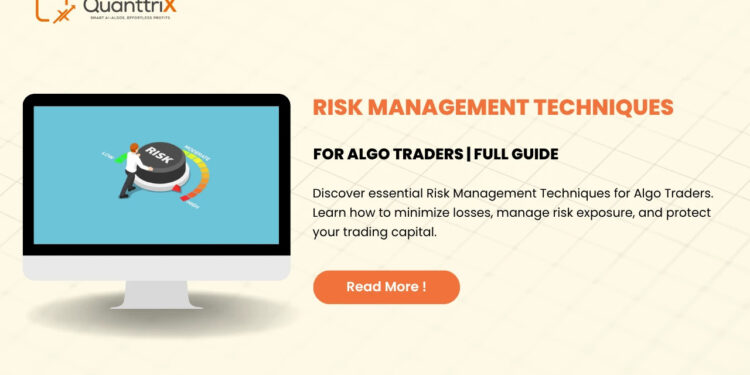Risk Management Techniques for Algo Traders
Introduction
If you’ve ever wondered how traders use powerful trading algorithms to make decisions in milliseconds, you’re not alone. Algorithmic trading, or algo trading, has taken the financial markets by storm. But here’s the catch: while the rewards can be big, the risks are just as real. Like driving a supercar at top speed, the thrill comes with dangers if safety measures aren’t in place. That’s where risk management techniques step in—they act as the seatbelt and airbag for algo traders navigating unpredictable markets.
In this article, we’ll decode risk management for algo traders in a simple, engaging way. Whether you’re curious about the latest innovations or searching for the best algorithmic trading software India, you’re in the right place.
Discover essential risk management techniques for algo traders. Learn how trading algorithm strategies and the best algorithmic trading software India help reduce risks.
What is Algo Trading and Why is Risk Management Important?
Algo trading is the use of computer programs that follow set instructions (known as trading algorithms) to make buy or sell decisions instantly. For example, instead of manually watching the stock market, a trading algorithm can scan thousands of data points in seconds and execute trades automatically.
Sounds great, right? But what happens if the algorithm is wrong? Or if there’s a sudden market crash? That’s when risk management becomes crucial. It’s the discipline of protecting your capital while allowing growth. In short, risk management is the shield that keeps algo traders safe from financial storms.
The Common Risks Faced by Algo Traders
Before we manage risks, we need to know what they are. Common challenges include:
- Market Risks: Sudden changes in prices that algorithms may not predict.
- Liquidity Risks: What if you can’t exit a trade because no buyers or sellers are available?
- Technology Risks: System crashes, internet outages, or coding errors.
- Overfitting Risks: When an algorithm works well in backtesting but fails in real trading.
These risks remind us that algo trading is not foolproof—it needs smart strategies to survive.
Understanding Trading Algorithms
Think of a trading algorithm as a recipe. Just like a recipe tells you how much salt and spice to add, an algo tells the computer when to buy or sell based on specific rules. Some algorithms are simple, like moving averages, while others are extremely advanced, considering AI and machine learning.
For traders, the question isn’t simply which algorithm to use—it’s how to control the risks associated with them.
Setting Clear Trading Objectives
Here’s one secret: not all traders want the same thing. Some want steady, small profits; others chase big wins. By setting clear goals like target returns, acceptable risks, and timeframes, traders can customize their risk management.
Example: A conservative algo trader might risk no more than 1% of their capital per trade, while an aggressive one may go as high as 5%.
Position Sizing: How Much Should You Risk Per Trade?
Position sizing is like knowing how many chips to put on the poker table. Too many, and you could lose everything in one round. Too few, and you won’t make meaningful gains.
Smart algo traders generally follow the 1-2% rule—never risk more than 1-2% of trading capital on a single trade. This ensures survival even if several trades go wrong.
Stop-Loss and Take-Profit: The Safety Nets
Stop-loss and take-profit orders are like airbags.
- Stop-loss: Automatically closes a losing trade before it sinks too deep.
- Take-profit: Locks in profits when your target is reached.
Without these, traders risk getting caught in emotional traps like “just a little longer” or “maybe it will recover.” Algorithms make these rules automatic, protecting traders from emotional decisions.
Diversification: Why Don’t Put All Your Eggs in One Basket
Have you heard the saying about not putting all your eggs in one basket? That’s risk management in a nutshell. Instead of relying on just one trading strategy or one asset, algo traders spread their trades across stocks, commodities, or currencies.
This way, if one market falls, the other may still rise. Algorithms make diversification easy by managing multiple assets simultaneously.
Backtesting Strategies Before Going Live
Would you buy a car without a test drive? Probably not. Similarly, no trading algorithm should go live without backtesting. This means testing the strategy on past data to see how it would have performed.
Backtesting highlights flaws, strengths, and possible adjustments. The key is to test under different scenarios, including market crashes and rallies, to avoid overconfidence.
Monitoring and Real-Time Adjustments
The stock market is alive, breathing, and changing every second. That’s why algo traders must monitor their systems like pilots watch dashboards. Even with automation, human supervision ensures algorithms stay on track and react swiftly to unexpected shocks.
Handling Market Volatility
Volatility is when markets swing wildly—sometimes in your favor, sometimes against you. Algorithms can amplify both gains and losses in such conditions.
Risk management techniques like reducing trade size or using volatility filters help traders stay grounded when markets turn chaotic.
Choosing the Best Algorithmic Trading Software in India
For traders in India, the choice of software makes a huge difference. The best algorithmic trading software in India offers:
- Reliability: Minimal downtime or technical issues.
- Speed: Millisecond-level execution.
- Customizability: Ability to design and adjust strategies.
- Integration: With Indian stock exchanges like NSE or BSE.
Some popular tools cater specifically to Indian markets, ensuring compliance with regulations and offering user-friendly features for beginners and experts alike.
Importance of Technology and Infrastructure
Imagine winning a Formula 1 race—you’d need not just a skilled driver but also a high-performance car. In algo trading, technology is the car. Stable internet, low-latency connections, and reliable servers are essential to avoid slippage or delayed executions.
Psychological Aspects of Algo Trading
You may think that algorithms remove emotions—but it’s not always true. Traders still face stress about whether their code will perform. Risk management prevents emotional decisions like over-optimizing or panicking during downturns.
Regulatory Compliance and Ethical Trading
In India, the Securities and Exchange Board of India (SEBI) sets strict guidelines for algo traders. Regulators want to ensure that trading remains fair and transparent. Ignoring compliance not only risks legal consequences but can also damage credibility.
The Future of Risk Management in Algo Trading
With AI, machine learning, and big data analytics, risk management is getting smarter. Future algorithms might predict risks in real time and adjust strategies automatically, functioning almost like self-driving cars in the financial highway.
Conclusion
Algo trading is powerful, exciting, and fast-growing. But without strong risk management techniques, it’s like driving without brakes—it may end in disaster. By focusing on position sizing, stop-losses, diversification, backtesting, and choosing the best algorithmic trading software in India, traders can balance risks and rewards effectively.
Remember: in trading, survival is just as important as success.
FAQs
1. What is the biggest risk in algo trading?
The biggest risk is market unpredictability—algorithms may not handle sudden shocks like crashes or volatility spikes.
2. How much should an algo trader risk per trade?
Most experts suggest limiting risk to 1-2% of total capital per trade.
3. Is backtesting enough to guarantee success?
No. While useful, backtesting doesn’t guarantee future success because real-world conditions often differ from historical data.
4. Which is the best algorithmic trading software India?
Several platforms serve Indian markets, and the best one depends on individual needs like speed, reliability, and exchange integration.
5. Can algo trading be done without human oversight?
Not advisable. While algorithms automate trades, periodic human monitoring is essential to manage unexpected risks.












